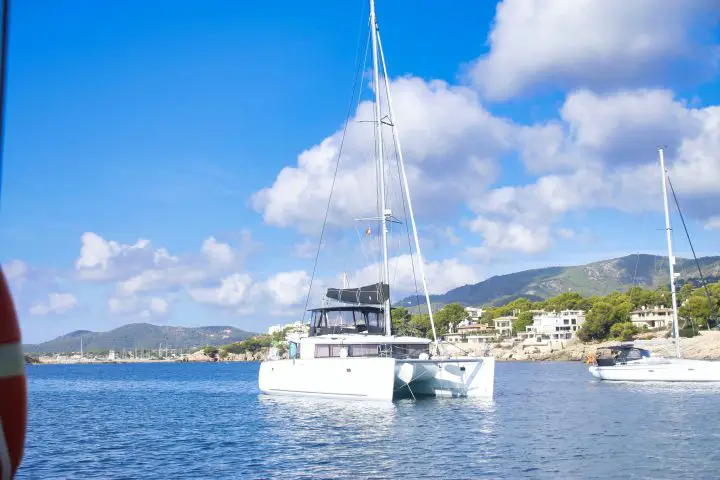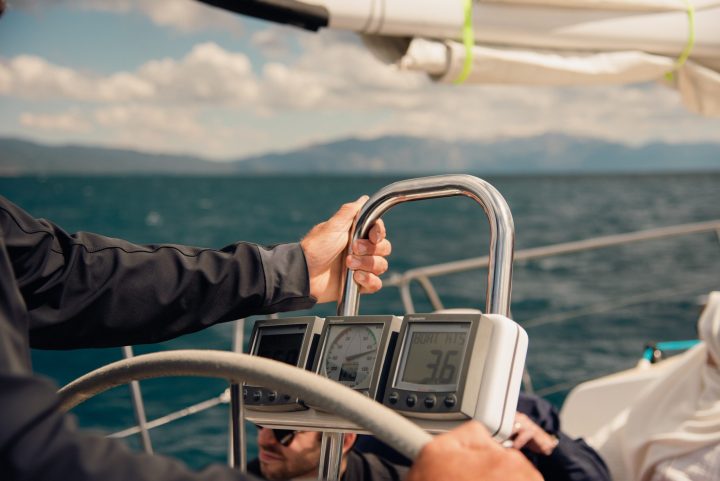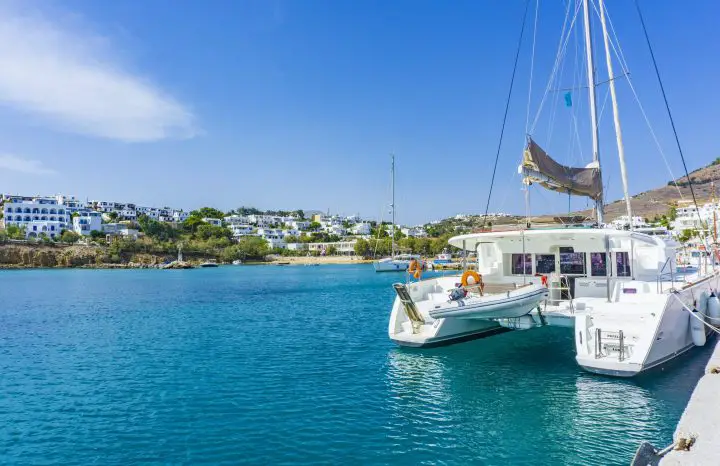You’ve probably heard that one of the best reasons to get a catamaran is because they’re fast. After all, there’s a race any time there are two sailboats on the same waterway.
But like all things in boating, speed is a relative term. Catamarans seem fast to those coming from slow and heavy monohull sailboats, but cruising catamarans are still pretty slow vessels. There are indeed high-tech racing catamarans breaking speed records all the time. Still, the vessels that most liveaboard cruisers venture out on are only slightly faster than their monohull counterparts.
For this article, we will look at the types of catamarans people live on and cruise on. Forget about those fantastic America’s Cup yachts or those multihull go-fast fishing boats for a few minutes.
I have had experience cruising and living aboard both catamarans and monohulls. For five years, my wife and I enjoyed catamaran sailing on a Lagoon 380. We then switched—for many reasons—to a Cabo Rico 38. The Cabo Rico is a traditionally-designed monohull with a full keel and a heavy displacement. In other words, it’s about as far away from a “speedy” catamaran as one can get.
Table of Contents
- How Fast Can a Catamaran Go?
- Measuring Catamaran Speed
- Catamaran Speeds vs Monohull Speeds
- Speeds of Various Types of Sailing Catamarans
- Catamaran Top Speed
- FAQs – How Fast are Catamarans?

How Fast Can a Catamaran Go?
There’s no doubt that catamarans are some of the fastest sailboats around—but there’s also a lot of misinformation and misunderstanding online about how fast they really are.
Realize that not all catamarans are created equally. There are cruising catamarans built to carry their passengers in comfort. And then there are racing catamarans built for nothing but speed. Somewhere in between, there is a poorly-defined category of “performance cruising” catamarans that stir passions.
So, are catamarans fast? Well, it’s all relative. But, if you compare them to monohull sailboats of similar sizes and capabilities, the catamarans are usually faster for several reasons.
The speed difference is even harder to measure in the cruising catamaran category. One of the reasons catamarans beat monohulls during races is because they are built light with no ballast. But a heavily-laden cruising cat ready for an ocean crossing is hardly “lightly loaded.” Will it still beat a similarly heavily-laden monohull? Sure! But probably not by as much as you might think.
Measuring Catamaran Speed
Boats measure their speed in knots. Traditionally, this was measured by a tool known as a knot log. The modern equivalent is an underwater instrument with a spinning wheel that effectively measures the speed of the water passing over the hull. So long as no currents are present, that speed will equal the boat’s speed over the ground (SOG).
Satellite navigation allows us to measure our SOG more accurately, but this isn’t a great indication of boat performance since it will be affected by tides and ocean currents.
For landlubbers, one knot is equal to about 1.15 statute miles. So, in other words, when we say that a sailboat cruises at 6 knots, it means it’s going about 7 mph.
But before going any further, consider this—the maximum speed that a sailboat makes is generally a pretty meaningless number. Maybe the knot log pegs to 13 knots for a few seconds, thanks to a strong gust of wind while you’re headed down a large swell. Does this mean you’re driving a 13-knot boat?
A voyaging sailor who has made a long passage will have little interest in this sort of number. When you’re crossing oceans, what really matters is how many miles pass under the keel each day. The more miles you tick off, the shorter the passage. So most sailors learn quickly to look past the “fastest speed in knots” number and find real-world stats on passage miles.

Catamaran Speeds vs Monohull Speeds
Comparing speeds between radically different sailing vessel hulls is like comparing apples to oranges. Even seemingly similar boats, like “cruising sailboats,” the differences between one and the other are endless.
For example, let’s say you wanted to compare 38-foot monohulls to 38-foot catamarans. The speed of a monohull is limited by waterline length, which means you’d have to look at a hull that is significantly more than 38 feet in most cases. On the other hand, the catamaran is known for long swim platforms on inverse transoms and plumb bows—meaning most 38 foot cats have nearly 38 feet of waterline.
Then, what sort of hull design makes a fair comparison to a catamaran? Would it make sense to compare a transitional, salty 38-footer with a full keel? Probably not. Most sailors interested in the cruising catamaran lifestyle would more than likely be comparing it to a modern monohull with a flatter bottom, fin keel, and spade rudder.
What about the catamaran? There’s a lot of variation in the catamaran field regarding performance. If speed is your goal, you likely want to compare the high-end performance brands—Outremer, Gunboat, HH, and the like. These boats are becoming more popular, but most cruising cats you see on the water are not performance models. Instead, they are the big and comfortable cruisers made by Lagoon, Leopard, or Fountaine Pajot.
Finally, how can you fairly compare the stats? Boats sail differently in different wind speeds and at different points of sail. In other words—there are a lot of variables that make it hard to answer the question, “How fast can a catamaran go?”
Polar charts for each vessel can provide some clues to make a somewhat fair comparison. Polar charts are graphical plots of a sailboat’s performance in different wind conditions and at different points of sail. Manufacturers seldom publish since no two are ever perfectly alike. They are less of a boat specification and more of one sailor’s results for a particular boat. Most owners make their own polar diagrams, but they’re still a tool for those looking to get an idea of a model’s performance in the real world.
Speeds of Various Types of Sailing Catamarans
There are several distinct catamaran classes, and predicting speed means understanding what the designers were building the craft to do. You might be surprised to learn that the first “modern” catamarans popped up in the New England racing circles in the late 1800s. Nat Herreshoff’s Amaryllis is particularly famous from the time.
Since then, catamarans have been synonymous with speed. But in today’s world of many different multihull designs, it’s important to set your expectations accordingly. As you would not buy a Ferrari for its cargo space, don’t expect your minivan to win any races at the track.
Sailing Cruising Catamarans
Examples of cruising cats include popular models made by the big-three catamaran makers—Lagoon, Fountaine Pajot, and Leopard. However, there are dozens of other companies making these boats. The market and industry for cruising catamarans have never been larger.
Most of these boats are engineered to provide comfortable accommodations for voyaging. They first became famous as vessels for sail charter holidays, where their huge cockpits and private cabins made them much more popular than the smaller and cramped monohull options.
As a result, they’re not built with high-tech components or super lightweight performance rigs. Instead, they’re the catamaran equivalent of a Hunter or a Catalina sailboat—mass-produced on an assembly line. That keeps prices lower than other types of catamarans, but it also means that they’re not winning any races. The makers use traditional layups with end-grain balsa-cored fiberglass to keep costs down. In addition, they usually feature stub fin keels, which are foolproof to sail but will not provide the upwind performance of a lift-making daggerboard.
Still, without ballast and when lightly loaded, cruising catamarans can move. They show their colors in light air when heavy displacement-hulled sailboats usually make their poorest showing. Since these moderate conditions also make for great cruising, these boats can provide a lovely ride in smooth weather.
Cruising catamarans can’t plane or anything, but their narrow hulls create an effect that means they can beat the hull speeds of a similarly sized monohull. Of course, it’s not a precise number since every boat and crew is different, but generally, you could expect speeds to be about one and a half times that of a same-sized monohull.

Performance Cruising Catamarans
These catamarans are still rigged for comfort, but they’re built using the highest-quality and lightest-weight materials. While their hulls are rigged for comfortable living, they are generally designed much sleeker than regular charter-style cruising catamarans. The hulls are narrower, and you’re unlikely to see tall flybridges or forward lounge seating.
Several companies are making these boats. But in the world of catamarans, a performance cruiser is the upper end of the market. If you want a car comparison, Lagoons are something like a Chevy sedan, whereas an Outremer is like an M-series BMW. A Gunboat would be even more exotic, like a Ferrari. Not only are they more fashionable brands, but they’re also made to higher standards with cutting-edge designs.
It’s also worth noting that the category of “performance cruising cat” is a sliding scale. Some companies make vessels with better materials and craftsmanship than the cruising cats but aren’t designed for speed. Others build cats that are all about performance with few amenities.
With every new model, companies building these cutting-edge boats are attempting to boost the “performance” and the “cruising” aspect of their vessels. As a result, amenities and speed continue to get better and better.
Racing Catamarans
Any racing sailboat is not designed for comfort. Especially on a catamaran, accommodations take up space and weigh the boat down. True racing vessels are designed to not worry about the crew but optimize every element for speed. Once the boat is designed for the desired performance, they’ll squeeze in bunks and storage wherever they can.
As such, there’s not much point in comparing them to liveaboard or cruising sailing vessels—they are too different. Some modern racing catamarans even fly above the water on foils. This makes for a high-speed boat and a considerable risk for sailors traveling for pleasure. Gunboat tried to make a foiling cruising cat in the G4 model, but it didn’t go so well for them.
Power Cruising Catamarans
Power cats run the same gamut of designs that sailing catamarans do. Power catamarans and sport catamarans designs are popular in powerboat circles for the same reasons they are in the sailing world–their hull designs allow for smaller underwater profiles and high speeds. There are many fast catamarans out there with twin engines and average speeds of well over 70 knots. Most recreational vessels cruise at about 20 knots, however.
Power catamarans also offer a smooth ride, making them a popular choice for large vessels like passenger ferries. There are even military vessels that use two hulls, like the stealth M80 Stiletto.
Catamaran Top Speed
As you can see, catamaran speeds vary from just slightly better than monohulls to extraordinary flying machines. But cats are about much more than just speed. Their open and bright living space makes living aboard an entirely different experience than living on a monohull. Their cockpits flow into their salons for a full-time outdoor living feel that no other type of vessel can match. There are many reasons to choose a catamaran as a liveaboard sailboat.
FAQs – How Fast are Catamarans?
How fast is a catamaran?
The answer depends on many other questions, like what sort of catamaran is it? And if it’s a sail cat, how fast is the wind blowing?
Sailing catamarans come in all different shapes and sizes. Some are optimized for living space and comfort, while others are designed with fast cruising speeds being the sole goal of the boat. The Gunboat 68, one of the fastest cruising sailboats currently made, can exceed 30 knots.
The world of power cats is much the same. Some power cats can do well over 70 knots, while most cruising boats top out at around 20 knots.
Do catamarans have a hull speed?
A hull speed is a characteristic of traditional displacement-hulled sailing vessels. The properties of the hull shape under the water create drag that limits the overall speed that the vessel can achieve. Even if you keep adding more power (or more wind), the vessel cannot exceed its designed hull speed for any length of time. Hull speed is a factor of waterline length.
Multihulls, however, have an entirely different underwater profile than monohulls. Their narrow hulls and shallow keels mean that drag is not the limiting factor. With this in mind, designers can tweak catamaran hulls to plane and cruise well above the hull speed of a similarly sized monohull.
What is the fastest cruising catamaran?
The market for fast-moving cruising cats has never seen more innovation than in the past decade. This type of boat has taken off, spurred in part by new designs and the overall popularity of multihulls for cruising. The industry leader in fast multihulls is generally considered the French-based company Gunboat. After all, one of the company’s mottos is “Life is too short to sail a slow boat.”
The company’s largest boat to date is the Gunboat 90 Sunshine. However, the delivery of the company’s current flagship, the Gunboat 68 Condor, from France to St. Maarten, provides some real-world numbers. In the delivery crew’s words, “Our max speed exceeded 30 knots a couple of times, and the max 24-hour run was 328 nm.” To save you the math, that works out for an average speed of 13.7 knots for their best day.
